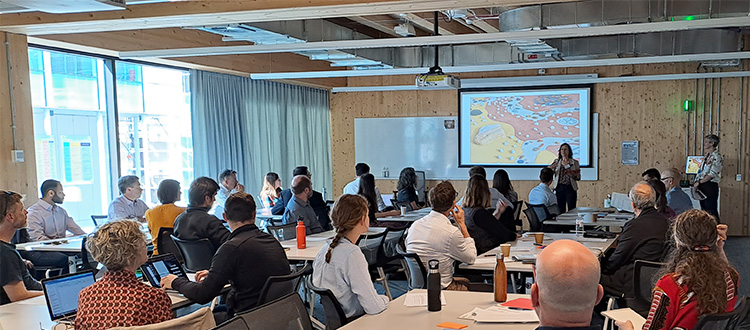
13 February 2023
By Louise Bardwell
On Monday 28 November, the Battery Storage and Grid Integration Program (BSGIP) hosted the Future of Neighbourhood Batteries in Australia conference at ANU with support from the Victorian Government Department of Energy, Environment and Climate Action (DEECA). The conference brought together for the first-time key stakeholders and neighbourhood battery aficionados to participate in facilitated discussion on some of the unresolved and pressing questions regarding neighbourhood batteries. The sessions of the day included the current state of play, the work ahead of us, how to measure success, and the role of government and market bodies.
Introduced by BSGIP’s Marnie Shaw, the current state of play included an electricity distributor perspective provided by Alida Jansen van Vuuren from AusGrid, a policy perspective from Laura Lynch from DEECA, a consultant’s perspective from Anthony Seipolt, a social science perspective from BSGIP’s Hedda Ransan-Cooper, and a community retailer perspective from Nick Mason-Smith from Indigo Power. Covering key learnings from neighbourhood battery trials and research to date, Nick-Mason Smith provided an important ‘spanner in the works,’ reminding us not to be myopic in our conception of neighbourhood batteries by advocating for behind-the-meter models co-located with large loads like a sports field, community centre or small business (as with Totally Renewable Yackandandah’s YACK01 battery).
The ‘work ahead of us’ session was split across five main discussion areas: community benefits and participation, energy transition governance, network data and services, economics of neighbourhood batteries, and priorities for the Federal Community battery program. The main themes that arose from these discussions included the need for transparency in data collection, grant funding allocation, ownership, and operation; for co-design that embeds values and energy future visions; for local voices that incorporate diversity and listen to the community; for community support to give the community a level playing field with networks, reduce burdens placed on communities, and incentivise community engagement and; for accountability, ensuring merit criteria are used to regulate DNSPs and other network businesses, that benefits are fairly redistributed, and to encourage learning and growing.
A key message that came through the day was the need for ongoing discussions, anchoring the Federal Government’s current community battery program as an opportunity to initiate these discussions. We were all reminded that community batteries are not a ‘set and forget’ technology, and that this needs to be well understood and accounted for in all future community battery programs. Evaluation and monitoring will be pivotal and need to be used to support community groups without whom community batteries will be just another network-owned asset.
With applications for the Federal community battery program closing 24 February, we hope to see clear articulation and understanding of these themes and discussions in the program’s grant allocation and roll-out. Specifically, that the Federal program will reflect and incorporate the learnings from DEECA’s Neighbourhood Battery Initiative (NBI) and BSGIP research.
Find out more about the Neighbourhood Battery Initiative.
